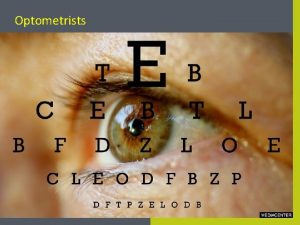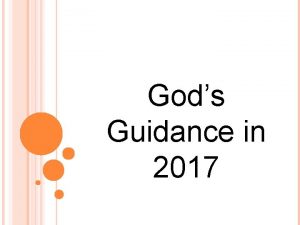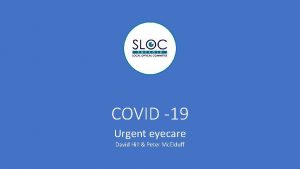MECS Guidance for Participating Optometrists North Staffs Eyecare



















- Slides: 19

MECS – Guidance for Participating Optometrists North Staffs Eyecare Services Re-launch, March 2019 Author: Mark Mc. Cracken

§ The Acute Eye Service has been re-commissioned as North Staffordshire Minor Eye Conditions Service (MECS) Introduction § Each accredited practice will have a contract with Primary Eyecare (PEC) Services § PEC Services will provide an end-to-end managed service

§ The PEATS service was first commissioned by Stafford & Surrounds (SAS) and Cannock Chase (CC) CCGs in July 2015. It was re-commissioned as a MECS service and extended to SE Staffs and Seisdon Peninsula CCG in May 2017 § Most common eye problems can be assessed and treated by local community optometrists § An evaluation of Stafford and Cannock MECS by SAS and Why MECS? CC CCGs (January 2016) has found: § 65% of MECS patients can be managed solely by community optometrists § 13% of MECS patients can be managed by community optometrists working with GPs § Only 22% need referral to the HES § 100% of patients were very satisfied with the service

§ The Acute Eye pathway service specification of April 2008 defines the GP practice protocol for referral into the scheme, and it is quite narrow in scope. The remit of MECS is much broader than this § MECS enables the triaging of not only acute referrals, but non-acute referrals also § GPs can choose to send referrals from non-accredited MECS vs Acute Eye Service optometrists into the service for refinement § In addition, MECS enables the treatment of minor eye conditions and also some minor eye procedures § No need for a separate Adnexal pathway - most of these conditions will now fall into the remit of MECS § Another important way in which MECS differs from the Acute Eye pathway is that the CCGs will now be contracting for the service via PEC Services. In this way, the CCGs hope to improve outcomes and efficiencies

§ The prime purpose of MECS is to reduce onwards referrals to secondary care § Where referral to secondary care is required, it will be to a MECS - Purpose suitable specialist with appropriate work up, initial diagnosis and urgency § There is no point in seeing these patients and then referring the majority anyway § The Metastorm IT system will be monitoring this, both by practice and by practitioner.

§ All provision of service must be recorded on Metastorm. It’s the only way you’ll get paid § All contacts regarding MECS should be recorded in your practice records, even if they don’t result in an appointment. This is for your own protection, so that there is a record MECS – Key Points (1) § A “MECS Referral Form for GPs” document has been uploaded to the Map of Medicine. This will list the inclusion/exclusion criteria for the service to GPs and to their staff § All participating MECS practices must triage the referral within 48 hours (24 hours if MECS URGENT) § As a minimum, the patient will be seen by the MECS service within 14 days (MECS ROUTINE). However, urgent referrals shall be seen within 24 hours (MECS URGENT)


§ MECS referrals will be sent directly to your practice via GPs, via PEC Services’ electronic referral hub, and occasionally from non-accredited optometrists and DOs, plus self-referrals from patients § You must complete a triage of referrals into your practice via a MECS – Key Points (2) reception triage form, so that referrals immediately apparent as inappropriate are sent straight to the Emergency Eye Clinic with appropriate urgency without seeing them in MECS, or bounced back to the original referrer (with comments) without seeing them in MECS § In instances where the level of urgency is unclear, the triage should then be passed on to an accredited optometrist § If the practice doesn’t have the availability, then it is that practice’s responsibility to find the patient an appointment from another practice in the service, within the appropriate time window § It is anticipated that a relatively small percentage of patients that undergo community assessments will require follow up (just 5% in South Staffs MECS). A follow up appointment will be offered, where clinically necessary, by the accredited optometrist within 2 weeks of the initial consultation

§ PEC Services is providing an NHS. net address as a route into MECS for electronic referrals from GPs. § A triage clinician will pick up the referral and gauge the MECS – Electronic Referral Hub urgency, before instructing PEC’s service coordinator to fax it to one of the participating practices. § The practice would then be responsible for fitting the MECS referral into its clinics with the appropriate urgency, or finding an alternative provider if it does not have the capacity.

§ 1) Practices would be required to confirm with Alison that Electronic Referral Hub Failsafes they have fitted the MECS referral into its clinics with the appropriate urgency, or else found an alternative provider. § 2) Alison will keep a log of electronic referrals, and chase up practices if she doesn’t hear back from them. § 3) If patient can’t be contacted by the MECS practice, or DNA’s twice, then the referring GP must be informed.



MECS – Inclusion Criteria § § § Distorted vision § § Dry eye § § Flashes/floaters Ocular pain Systemic disease affecting the eye Differential diagnosis of the red eye Foreign body and emergency contact lens removal (not by the fitting practitioner) Epiphora (watery eye) Trichiasis (in growing eyelashes) Differential diagnosis of lumps and bumps in the vicinity of the eye Retinal lesions Patient reported field defects (NOT FROM SIGHT TEST) GP referrals (including referral refinement, and raised IOP/suspected raised IOP)

§ Sudden, persistent loss of vision <48 hours – urgent to EEC (<24 hours) § Sudden, persistent loss of vision >48 hours – urgent to EEC (<72 hours) § Sudden onset diplopia – urgent to EEC (<72 hours) MECS – Exclusion Criteria § Injuries: chemical, penetrating or post-operative infection – urgent to EEC (<24 hours) § Severe ocular pain requiring immediate attention – urgent to EEC (<24 hours) § Suspected retinal detachment – urgent to EEC (<24 hours) § Suspected vascular abnormality (Don’t forget Wet AMD and RVO pathways…)

§ MECS should not normally be used in the following cases: § Flashes and/or floaters if < 1 month has elapsed since the first full MECS consultation for the same issue § For removing in-growing eyelashes if < 4 months have elapsed since the first full MECS consultation for the same issue § For repeat dry eye / blepharitis consultations if < 4 months have elapsed since the first full MECS consultation for the same issue Use of MECS (1) § And in similar situations to the previous 2 points, e. g. transient loss of vision § Where the patient’s reported symptoms indicate that a sight test is more appropriate than MECS § Adult squints, long standing diplopia § Removal of suture § Repeat field tests to aid diagnosis following an eye examination (unless referred in by a non-accredited optometrist from a different practice) § Age related macular degeneration (unless disciform changes of recent onset are suspected)

§ There are other specific exclusions to MECS: § Patients identified to have severe eye conditions which need hospital attention, e. g. orbital cellulitis, temporal arteritis § Eye problems relating to Herpes zoster § Suspected cancers of the eye Use of MECS (2) § Patients cannot be treated under MECS if their signs or symptoms indicate they are more suitable for the following locally enhanced services: § North Staffordshire Direct Access Cataract (DAC) pathway § North Staffordshire & Stoke-on-Trent Glaucoma Referral Refinement (GRR) service § Staffordshire Diabetic Eye Screening Programme

§ A simple but important point to bear in mind is that a The use of MECS and Sight Tests MECS examination is not an adjunct to a sight test, it is an alternative for those cases where the symptoms do not seem to be obvious sight test material. In other words, in most cases, you choose and either perform a sight test and deal with what you find, or perform or refer for, a MECS § In a small number of cases the outcome from a MECS might be the advice that a patient should visit their own practitioner for a sight test, but it should be extremely rare (if ever) for a sight test to lead to a MECS examination

§ There are limited circumstances in which a non MECS-accredited registered optician may refer a patient to a MECS-accredited registered optician (either within the same optical practice, or to an alternative optical practice), where it is in the best interests of the patient. The main conditions to which such referrals may apply are: § a patient presenting with recent onset flashes and floaters MECS – Referral from Non MECSaccredited opticians § a patient with mild-to-moderate ocular pain § a patient requiring differential diagnosis of the red eye § For such patients, a sight test may not always provide an appropriate means of investigating and managing their conditions, and MECS often provides the best context for doing so. § Before referring the patient into MECS, there are two things that the non MECS-accredited registered optician must bear in mind: § One of the main purposes of MECS is to manage patients in primary care rather than secondary care, where possible. § It is important that the non MECS-accredited practitioner understands that their duty of care to the patient under GOS is unaffected.

Thank you : ) …any questions?
 Requirements for erf teacher 2
Requirements for erf teacher 2 New era eyecare
New era eyecare Treble concurrency
Treble concurrency Incisal guidance angle value
Incisal guidance angle value Indirect and direct guidance
Indirect and direct guidance Chapter 17:3 completing job application forms
Chapter 17:3 completing job application forms Participating contracts
Participating contracts Participating funding arrangement
Participating funding arrangement Thank you for participating images
Thank you for participating images Vopc
Vopc Situational leadership
Situational leadership 18:2 writing a cover letter and preparing a resume
18:2 writing a cover letter and preparing a resume Kyra is participating in a fundraiser walk a thon
Kyra is participating in a fundraiser walk a thon True north vs magnetic north
True north vs magnetic north Lesson quiz 14-1 north and south
Lesson quiz 14-1 north and south North east and cumbria ics
North east and cumbria ics The north pole ____ a latitude of 90 degrees north
The north pole ____ a latitude of 90 degrees north Datorkunskap för nybörjare
Datorkunskap för nybörjare Autokratiskt ledarskap
Autokratiskt ledarskap Humanitr
Humanitr





































